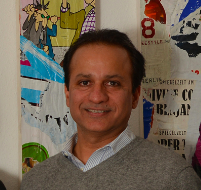
Oximity's team pose for a group photo in Berlin, Germany.
Oximity is a new website with the modest goal of “reengineering the news industry”. It's neither an aggregator nor a citizen journalism site, but something that encompasses both.
Behind the bravado is the site's co-founder Sanjay Goel who together with a Berlin-based team has developed a technically sophisticated and ambitious tool for news reading and writing.
The goal is to offer “news from the source” as an alternative to traditional mainstream news providers. Any organization or individual can use the site as a publishing platform with their own name and branding. And readers can easily sort through vast amounts of content (in any language) by creating “Playlists” of sources or keywords (Tags) on a personalized homepage.
Partnership
Global Voices stories in all languages are now available on Oximity, where readers can choose to follow specific variations of language or topic (say, Spanish and French stories about Ethiopia).
As a feature of our partnership Oximity has given Global Voices stories special status on their homepage as a “recommended playlist”.
The list of publishers is quickly growing as Oximity focusses on expansion and honing in on a business model. The site is still in beta and Oximity pride themselves on adapting quickly to feedback.

Oximity's homepage (Nov 19, 2013)
Interview with Oximity's Sanjay Goel

Sanjay Goel, Co-Founder
What motivated you to launch Oximity?
The news industry's fundamental model has not changed since its invention more than 400 years ago. It's time to make a fresh start.
Serious lack of trust in the media is a problem in most countries thanks in part to media consolidation and vested interests. On Oximity all news will come from the source, because the source is by definition the expert.
Journalists are skilled in news writing and storytelling, but most fall short when it comes to reporting that really requires expertise.
Doesn't relying on “sources” like organizations or individuals introduce problems with quality or issues with bias?
Yes, that can be a problem. Our solution is to enable our users to proofread, translate, and offer public feedback on stories, a bit like on Wikipedia. Oximity also provides tools to allow users to contextualize, refute or add to published articles, allowing the reader to see multiple perspectives in one place.
Companies like eBay and LinkedIn create online trust through ratings, public scrutiny and feedback systems. We are applying these learnings to the news industry.
What are your long-term goals?
We want Oximity to be a non-partisan, secular, mainstream news platform that offers solutions to the flaws of the current news model. Our agenda is to promote objective reality — or what some people call ‘the truth’.
We want Oximity to be financially self-sustainable. We are learning from the revenue models of large internet companies that are not primarily in the news business, including eBay, LinkedIn, Facebook, Twitter and Google.
What are some of the technical features of Oximity you are excited about?
Thanks to extremely versatile technology anyone can plug their content into Oximity, and organizations can also display news from Oximity on their own websites. This creates a two-way flow of news for a critical mass of self-empowered and interconnected writers and readers.
Instead of organizing news under just a few broad categories like most other sites, we sort vast amounts of information using automatic and semi-automatic tagging that helps ensure Oximity is relevant to each individual.
Additionally, behind the scenes, we use a technical standard for our articles (rNews) that makes them easily discoverable in search engines.
We solved the need for verification of writers with a unique peer-to-peer authentication system. Oximity can approve writers we know, and approved writers can approve other writers they know. We were inspired by similar ‘web of trust’ models used in open-source software development.
Also, we have implemented special algorithms for scoring of articles that help the best rise to the top, and an advanced search for article recommendations and discovery.
Why did you chose to make your website multi-lingual?
As our world comes together via technology, language differences can still be a barrier to information sharing and mutual understanding. No part of the world should be left behind because they don't use English. Technology should adapt to people, not vice-versa. Therefore, we facilitate writing and reading news in more than 200 languages.
Users can manually translate any article to increase awareness of an issue in their own community, and we also have an automated translation feature in 40 languages.
Our readers can set up Playlists to follow topics of interest through Tags, even in languages they don't understand – that is a major breakthrough for news consumption.
Why do you wish to share Global Voices stories?
We believe that each human being is equal – in absolute terms, with no exceptions. One would expect the mainstream media to reflect the issues of everyone. But most of the media that has global reach and impact is from the ‘rich world’, so we end up focusing on issues relevant to only a few countries disproportionally.
Global Voices helps correct this imbalance by bringing news from the entire world. You have built an amazing and dedicated community over many years, and it is a privilege to share this content with Oximity's users.







1 comment